When I was out at my local Warhammer store last week, picking up my painting handle, the owner let me know that they were running some Kill Team demos later in the month. I stopped by this past weekend and had the chance to get a little taste of it to see what it was all about.
There are lots of sites dedicated to GW’s 40k universe and all its games and I am definitely not in that group. I know next to nothing about the universe or various editions of the rules and haven’t really had any desire to jump in due to the “where do I even start” and “I don’t want 100s of models to put together and paint just to start a game” fears. Warhammer 40k has always seemed like the ultimate in “lifestyle” games and I’ve never wanted to dedicate so much of my hobby time to one single resource. I focus on games but no individual one to that degree.
So why even have an interest in Kill Team? First off, it is a smaller commitment of squad vs squad in a skirmish setting. The Starter set looks like a “all you need” set that doesn’t just give you half the figures you need to play with and part of the bigger game itself. And it should at a cost of $130 MSRP. I’m ok with starters being only a small faction of the game itself so you can taste it if I’m going to go all in eventually but with 40k, I’m a bit weary and don’t want to fall into a huge time/money sink. A self-contained starter that is ready to go and deep enough to keep me busy without chasing more models seemed like a good fit and one where I can dip my toe into the world of 40k without getting soaked.
As the post title alludes to, I did not get a full game or even a full demo of the game so I will try to temper my judgement with the fact that I really only got through a single round of combat and we were stripping down a lot of the rules to expedite the experience. The main parts that we stripped down were the extra ability powers of the figures and everything else we learned as we encountered them.
We started by breaking off into teams of two with a pre-set squad. I don’t believe the squads we used were the ones from the box as they hadn’t assembled them yet but Kill Team allows players to pull squads from all the factions in the current 40k universe so several players had units on hand to fill out the game. Again, I don’t know anything about the game universe so I don’t know who these blue-green dudes are but I did recognize the unpainted grey enemies as some sort of Space Marine group.
We rolled to place figures and starting with the lowest rolling player, placed all the figures in the designated deployment zones.
After deployment, we started round one. The round starts with players rolling initiative for the movement portion of the round. In descending initiative order (highest first), players choose their movement option for each figure individually. The movement options are pretty obvious with things like making a standard move up to the figure’s movement value (in inches, this is a still a tabletop minis game so get your rulers ready or use the flimsy clear plastic one provided), making a charge, or readying to fire. A charge is a simple declaration of target and rolling two dice, moving the distance shown on the 2d6 total. If people thought A Song of Ice and Fire was mean when it came to charges, it seems like this game is just as brutal if not more. Though, I will say, I didn’t see that a figure was then punished again when failing to charge and forced to make a morale check like ASOIF, they just get to look like an idiot sitting out the middle of the field.
Readying to fire allows a ranged unit to stay put and have the first opportunity to shoot during the upcoming attack round. I had a bunch of long range guys that could shoot across the board so I readied everyone and waited for the enemy to approach. The other players completed their various move actions and we moved on to the attack phase.
Sure enough, a grey Space Marine had wandered into view and I drew line of sight on him. Line of Sight (LOS) in this game is “true LOS” so you get down to what the figure can see. Before we start attacking, we roll initiative again and I get the highest. Attacking starts with all the models that readied during the move phase and you go in initiative order (highest to lowest) activating your readied figures until all have gone.
I shoot with one of my sniper figures at the approaching Space Marine. Firing is a series of modifiers to figure out the target number and checking range. If your target is within half your total range distance, you can fire at them normally, otherwise you’ll have a penalty. Cover also adds a penalty as does things like morale of your whole squad and wounds you’ve acquired. In this case, I was within range to shoot normally and the only modifier was the Space Marine’s cover.
I got off two shots and both hit. Next we compare the attack strength versus the target’s armor to determine the target value. I’m guessing a little here as I was just simply told “you need 4s to deal damage” and it seemed like that is how they calculated the number. I rolled successes again (actually my daughter was doing all the rolling and had some pretty hot dice). This triggered another roll to check how damaged the figure was. They need to roll low (or I was supposed to roll and wanted to get high, it wasn’t clear who was rolling it). If they roll low, they survive with just a flesh wound, otherwise they take a wound and usually die as most everything has only one wound. My opponent rolled low on both and gained two flesh wounds. Flesh wounds make the model just generally worse at doing almost everything as they stack penalties on top of most of the die rolls.
Having run through a round of combat, my kids were getting restless for lunch so I had to bail. Even though it was pretty short, I felt like I got a lot of detail on how this game might play and it was worth the trip out.
So that was my first taste of Kill Team. I have to admit that my excitement for the game has been diminished quite a bit even though we hardly got into the game. This is mainly due to the fundamental mechanics that I saw in combat. I’m used to running attacks with two combat steps, checking to hit and then confirming damage but Kill Team decided to add another check on top to determine the type of damage. While adding just one more check roll doesn’t seem like a lot, this will compound with dozens of attacks per round and sounds like it is just another rule to look up in the beginning while learning the game. I’m sure as you got familiar with everything, it could become second nature or maybe even allow for different dice colors to roll everything simultaneously but as is, it seemed overtly cumbersome.
To make matters worse, each of the die roll checks had numerous modifier options: is the model in cover, do they have flesh wounds, what is the morale of your team, distance modifiers, etc. And they aren’t consistent either. To Hit rolls take into account all of the above but damage only checks flesh wounds while the wound check then adds back in cover modifiers and flesh wounds, but this time on the target model. For the sake of a more realistic experience, I don’t think all the added conditions and roll check of a roll check of a roll check processes add to the game. Maybe they had to design that for balance purposes or it is how 8th edition Warhammer 40k works and their fans like it but it is a pretty big turn off for me as a new player.
I’m not outright saying I won’t try it again as I hardly scratched the surface as to what this game could be but I went in expecting a 40k version of Shadespire and got a full-on 40k game on a 30 inch by 24 inch game mat. That isn’t necessarily bad but the expectation shock has me really reevaluating my consideration for this game. I’ll try it again at Gen Con and try to get a fuller picture of the game before I make any final judgements. In some ways, this demo was great in that it allowed me to adjust my expectations before seeing it in full and without that, I would have probably made a quick decision at Gen Con to chalk the game up to “not for me.”
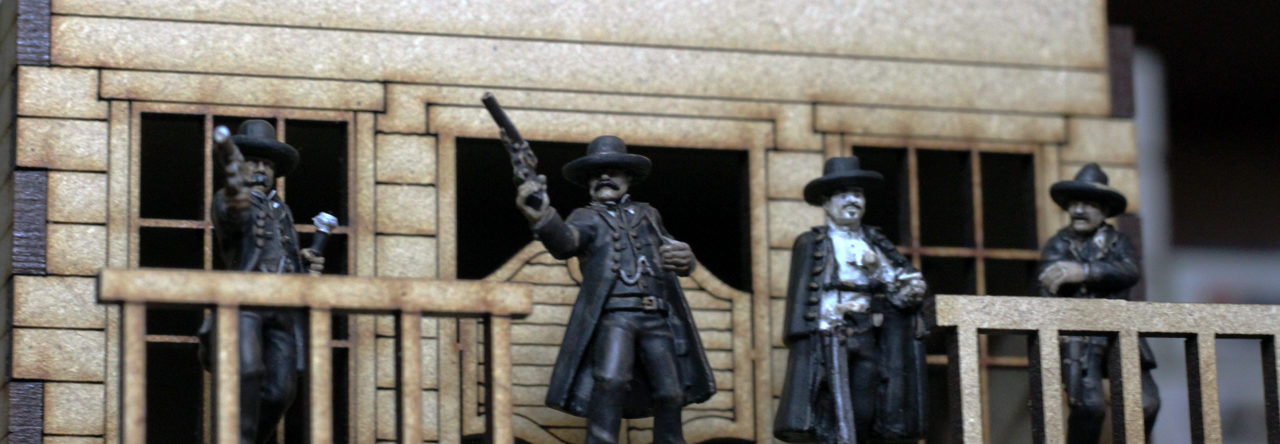
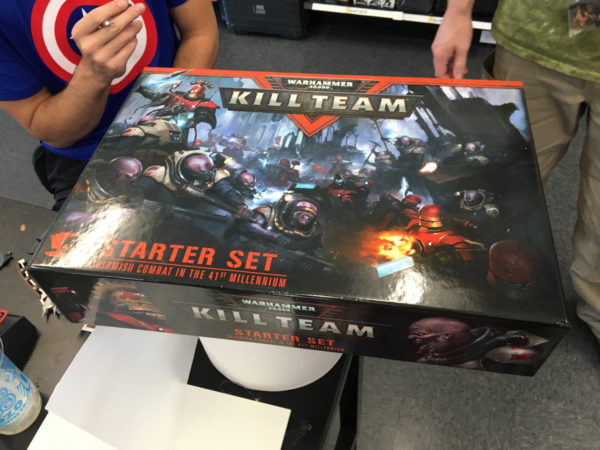
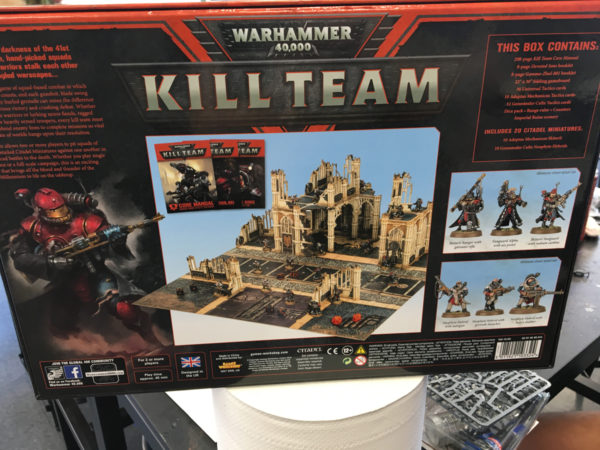
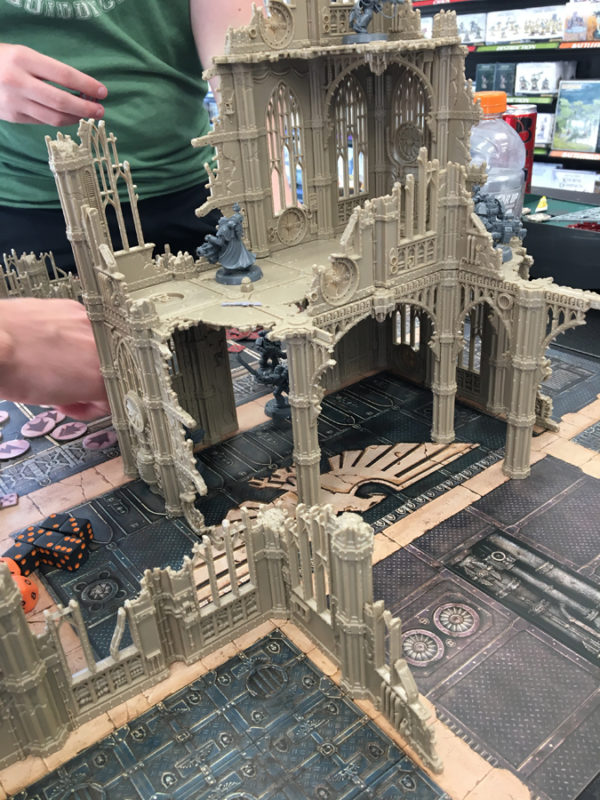

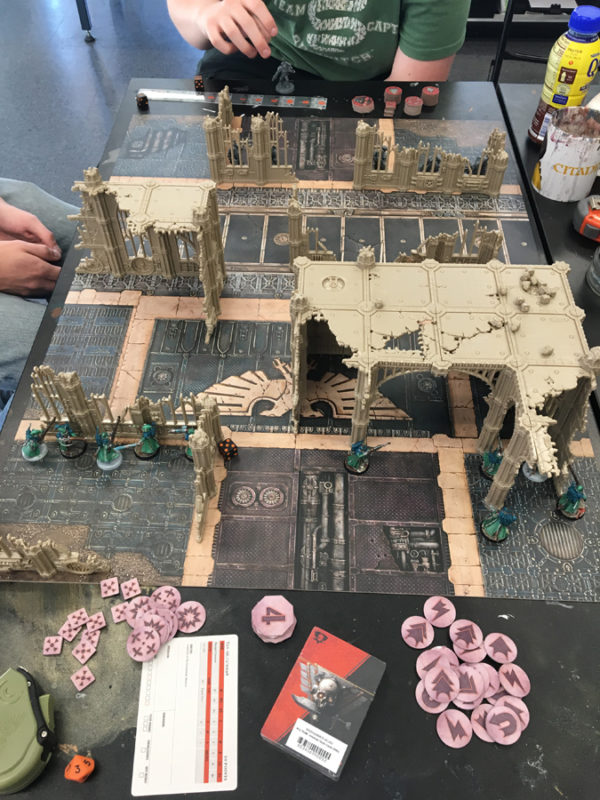

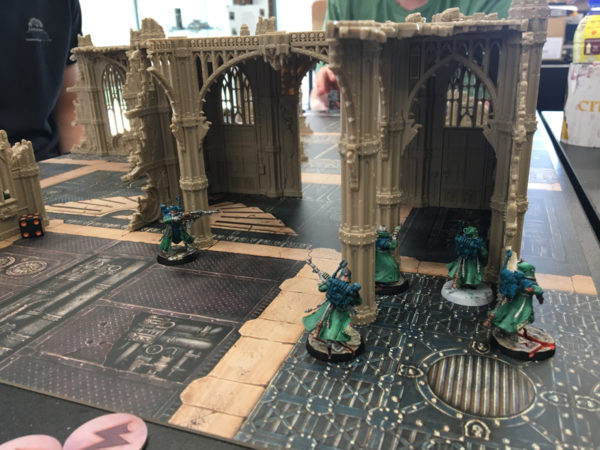
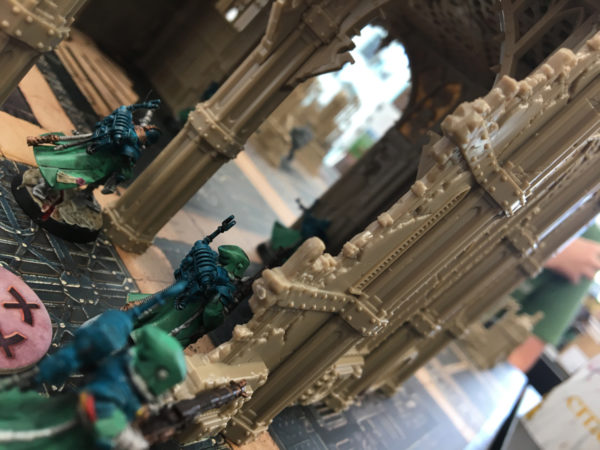

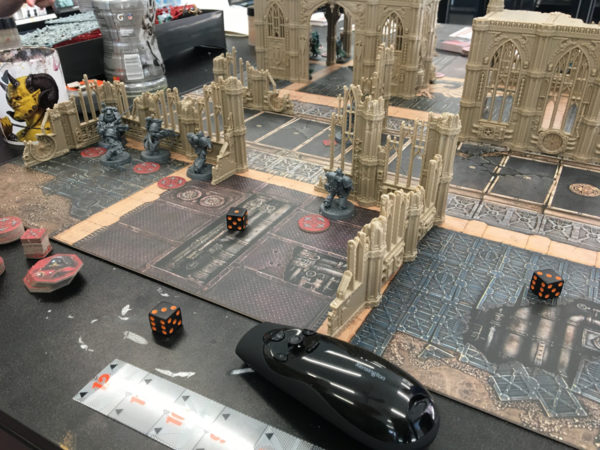
Russ Spears
I want to like Kill Team. I want to like a lot 40K stuff. I don’t though. 1/2 is the game play and rules – something just doesn’t feel right. The other 1/2, honestly, is that most of the people locally that play are way into the lore and “right” way to play (god forbid you use the color scheme on whatever unit you’re fielding).
Somewhere I saw it lauded, once upon a time, that GW games were the gateway to minis gaming. You would dip your toe in and see if you liked it, and if so you would eventually move on to better rules, better quality/more affordable minis. I’ve just kind of accepted that and haven’t looked at any GW games in more detail than my cursory “visit the local GW store and watch some demos” in the past… decade?
With that, I’m still envious of the 40K vehicles, especially airborne.
Oh, and if you haven’t seen Kevin Barrett’s semi-regular blog about the mostly-40K stuff he paints – http://mageknightkevin.blogspot.com/ – it’s awe inspiring.
Christian
Luckily, I haven’t had much exposure to the culture of 40k but the rules just aren’t there for me either. I think my main problem is that I have rule systems that I already like so with Kill Team I was hoping for a lighter game that doesn’t take multiple plays to understand the rules. Maybe it isn’t that bad and I’ll try it again at Gen Con (if I have time) and get a final verdict.
Thanks for the link! I haven’t seen his work but it looks great.